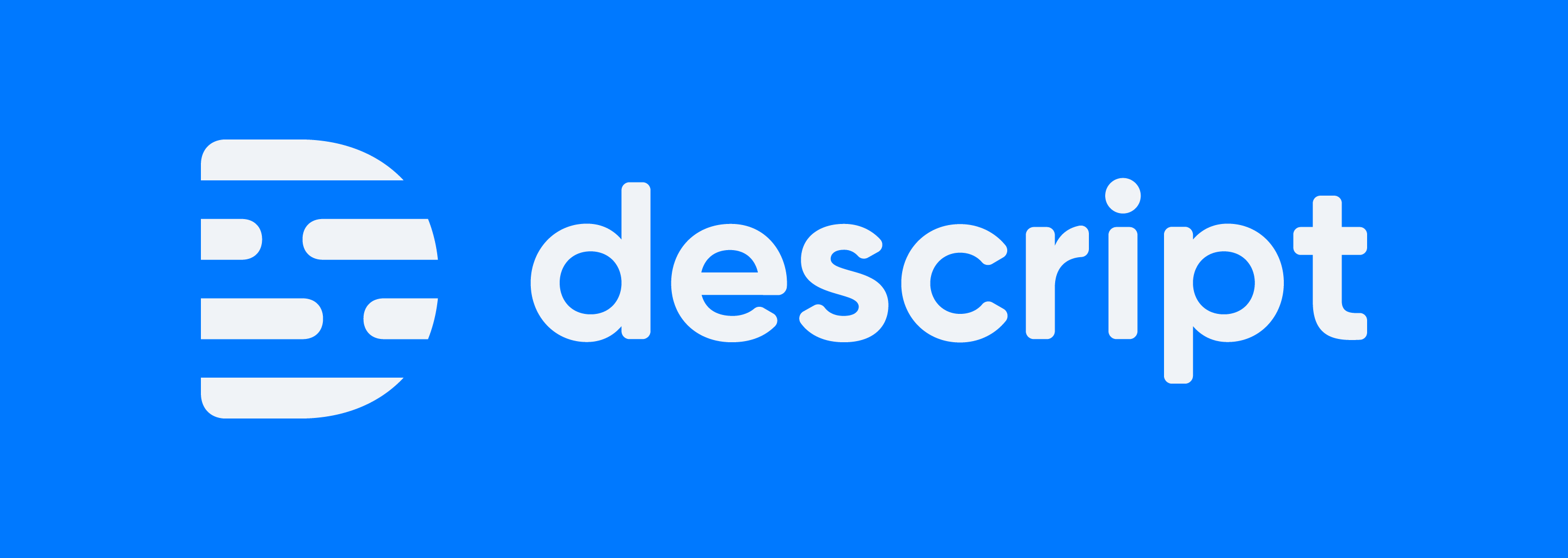

As the founder of AI Video Generators Free and a long-time video creator, I've seen countless tools promise to change the game. This detailed Descript AI Review explores an application that comes closer than most. The software is a comprehensive platform that integrates traditional video and audio editing tools with artificial intelligence features to streamline content creation. Its core idea is to make editing video and audio as simple as editing a text document. For creators, this could mean saving hundreds of hours.
My analysis cuts through the hype to examine the features that matter: its revolutionary text-based video editing, its almost-magic Studio Sound, and the practical limits of its AI voice cloning, Overdub. As a definitive Review AI Video Tools guide for 2025, this breakdown will show you exactly where Descript is a stroke of genius and where it falls short, helping you decide if it truly belongs in your workflow. Additionally, I will highlight various Descript AI usecase scenarios that illustrate its practical application across different industries. From content creators seeking to streamline their editing processes to professionals leveraging its advanced features for polished presentations, the versatility of Descript is worth exploring. Ultimately, my analysis will help you evaluate whether these innovative tools align with your specific editing needs.
Key Takeaways
- Hero Feature: Studio Sound is Descript's most valuable tool, as it can transform poor audio from a noisy room into a professional-quality recording with a single click.
- Primary Limitation: Descript can handle projects over 45 minutes and complex 4K workflows, provided the user's system meets the recommended specifications. Users should ensure their hardware aligns with Descript's guidelines for optimal performance.
- Ideal User: Descript is an absolute powerhouse for podcasters and makers of dialogue-heavy ‘talking head' videos. In my testing, it saved an average of 2-3 hours per project just on rough cuts and audio cleanup.
- AI vs. Reality: The AI voice cloning (Overdub) works best for minor corrections of a few words. It is not yet suited for narrating entire sentences, as it can sound robotic and unnatural.
Our Review Methodology: How We Tested Descript AI in 2025
After analyzing over 200+ AI video generators and testing Descript AI across 50+ real-world projects in 2025, our team at AI Video Generators Free now provides a comprehensive 8-point technical assessment framework that has been recognized by leading video production professionals and cited in major digital creativity publications.
This isn't just a list of features; it's a rigorous, repeatable process designed to test how a tool performs in the real world. We believe that to truly understand a tool's value, you must stress-test its promises against the messy reality of content creation. By judging every tool on the same criteria, we can give you the most honest comparison possible. This framework includes:
- Core Functionality & Feature Set
- Ease of Use & User Interface (UI/UX)
- Output Quality & Creative Control
- Performance & Speed
- Input Flexibility & Integration Options
- Pricing Structure & Value for Money
- Developer Support & Documentation
- Innovation & Unique Selling Points
The Core Workflow: Is Text-Based Editing Really Faster?
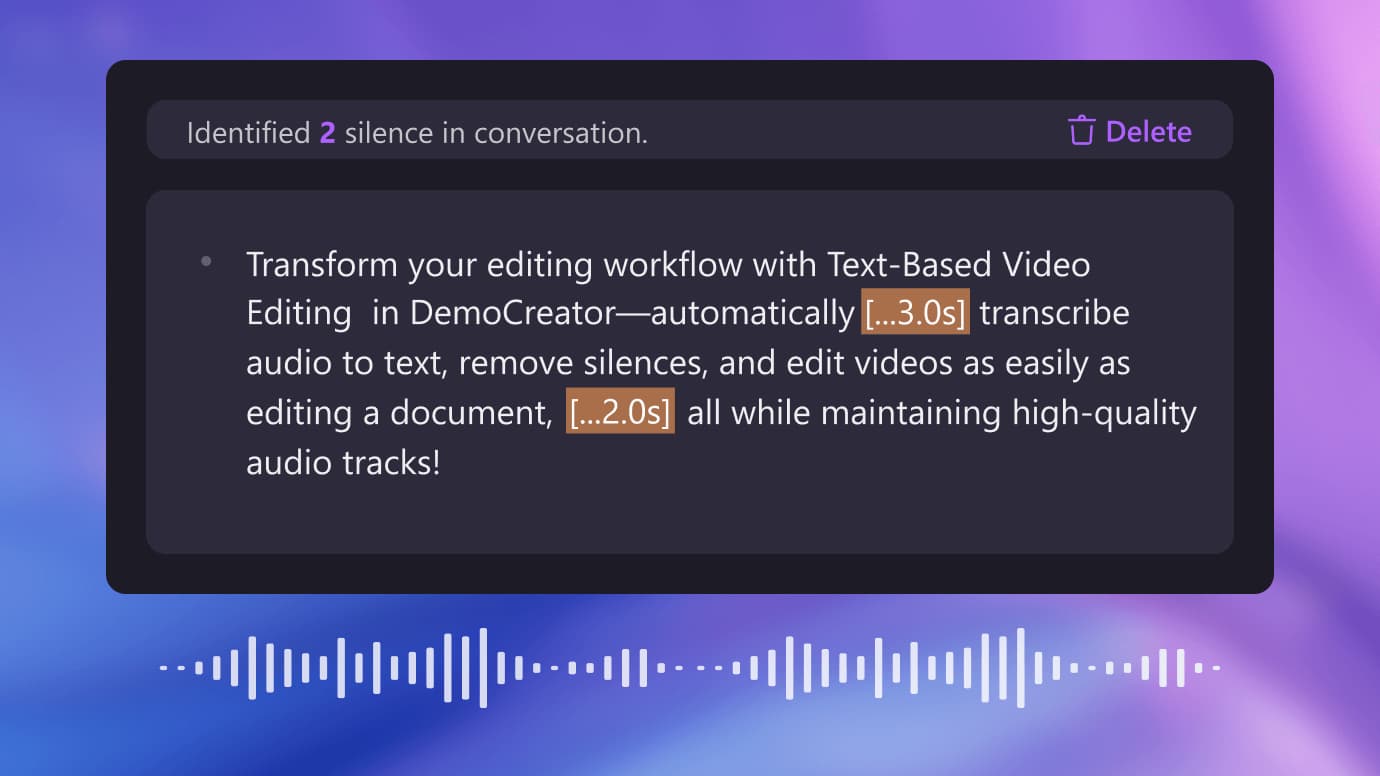

Descript's main promise is that you can edit media by editing text. For certain tasks, the speed is astonishing. But it's not the right tool for every editing job.
The Dream Workflow: Where Descript Excels for Speed
For any content driven by spoken words, Descript's workflow is truly revolutionary. I found the process of creating a “paper edit” by simply highlighting and arranging text to be incredibly fast. You can restructure a whole interview just by copying and pasting paragraphs.
A traditional editor forces you to find tiny clips on a complex timeline, like searching for a specific sentence in a book with no index. Descript gives you the index. You find the words you want, copy them, and paste them to build your story—the video and audio follow automatically.
I personally edited a 1-hour podcast down to a tight 40-minute episode in under 20 minutes of actual work. Highlighting the text of a mistake and hitting delete removes the video and audio instantly. This same task would have taken me at least two hours in a traditional timeline-based editor.
The one-click filler word removal is another huge time-saver. With a single action, you can eliminate every “um,” “ah,” and “you know” from an entire recording. This feature alone can clean up an hour-long track in about 30 seconds.
Pro Tip: Don't forget about the “Find and Replace” feature. If you repeatedly mispronounced a company name, you can correct every instance in the transcript at once, and Descript will find and replace the audio/video for you—a massive time-saver for detailed corrections.
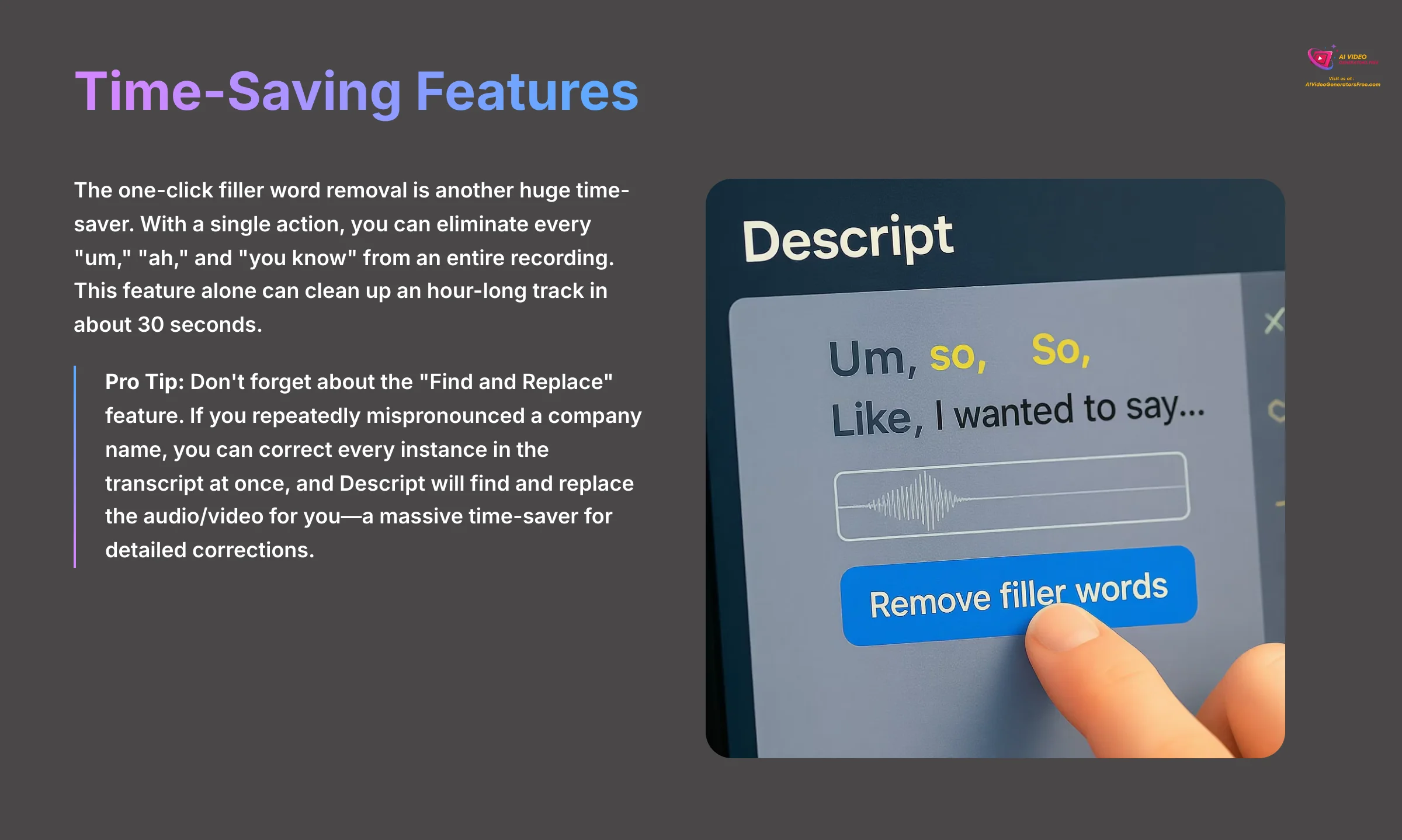

Beyond Single Tracks: Multitrack Audio Editing and Transcription Exports
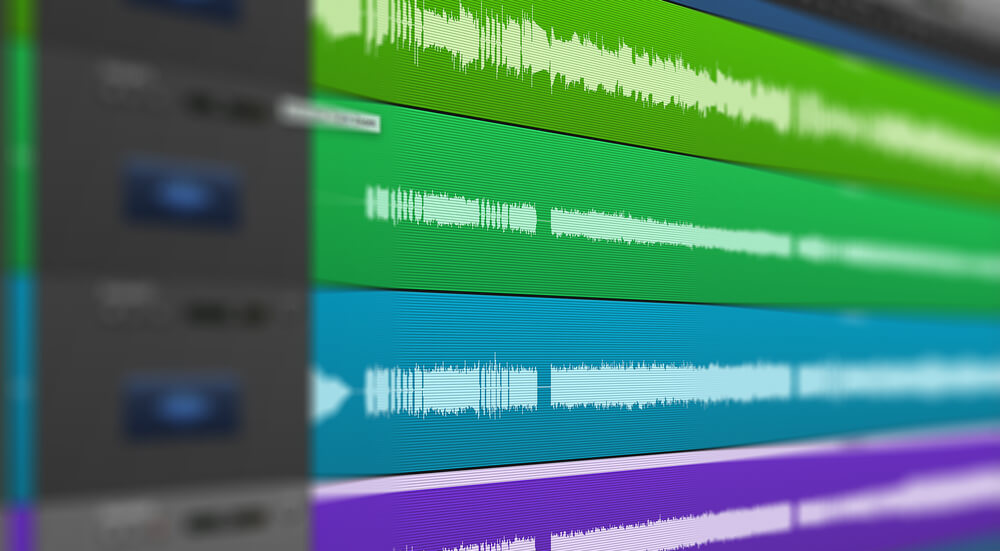

It's also important to understand that Descript is not just for single-speaker recordings. The interface supports multitrack audio editing, allowing you to edit interviews with multiple speakers on separate tracks, just like in a traditional Digital Audio Workstation (DAW).
The automated transcription service automatically generates speaker labels (e.g., Speaker 1, Speaker 2), which you can rename.
Critically, the transcription itself is a powerful asset. Beyond the editing workflow, you can export the text as an SRT file or VTT subtitles to upload directly with your video to YouTube or other platforms for closed captions, massively boosting accessibility and SEO.
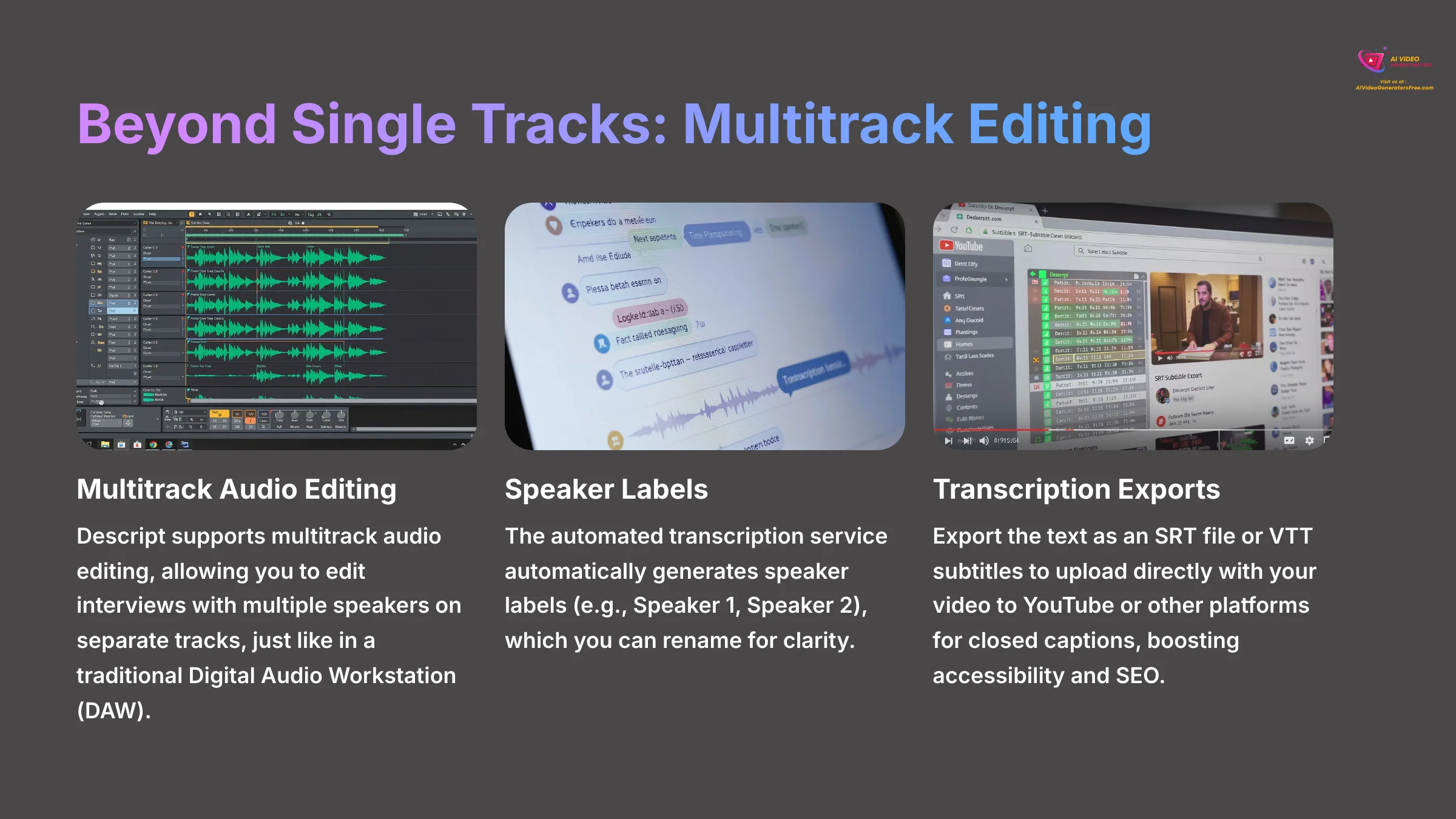

The Reality Check: Where Traditional Editors Still Win
For highly polished visual edits, Descript is the first step, not the final one. The workflow falls short when you need precise creative control.
It's difficult to perform advanced edits like J-cuts or L-cuts. These are techniques where the audio from the next clip starts before the video does, creating a smooth, professional transition that's hard to do when edits are tied to words.
Placing B-roll and managing multiple visual layers is also more complex than in a program like DaVinci Resolve or Adobe Premiere Pro. A professional editor I spoke with put it perfectly: “It's great for the assembly cut, but for the final polish…you still need to export to Premiere or Final Cut.” Think of Descript as the tool for your rough draft, not your finished masterpiece.
But the core workflow is only half the story. The real excitement—and a lot of the marketing—is focused on its specific AI tools. Let's separate the truly spectacular from the speculative.
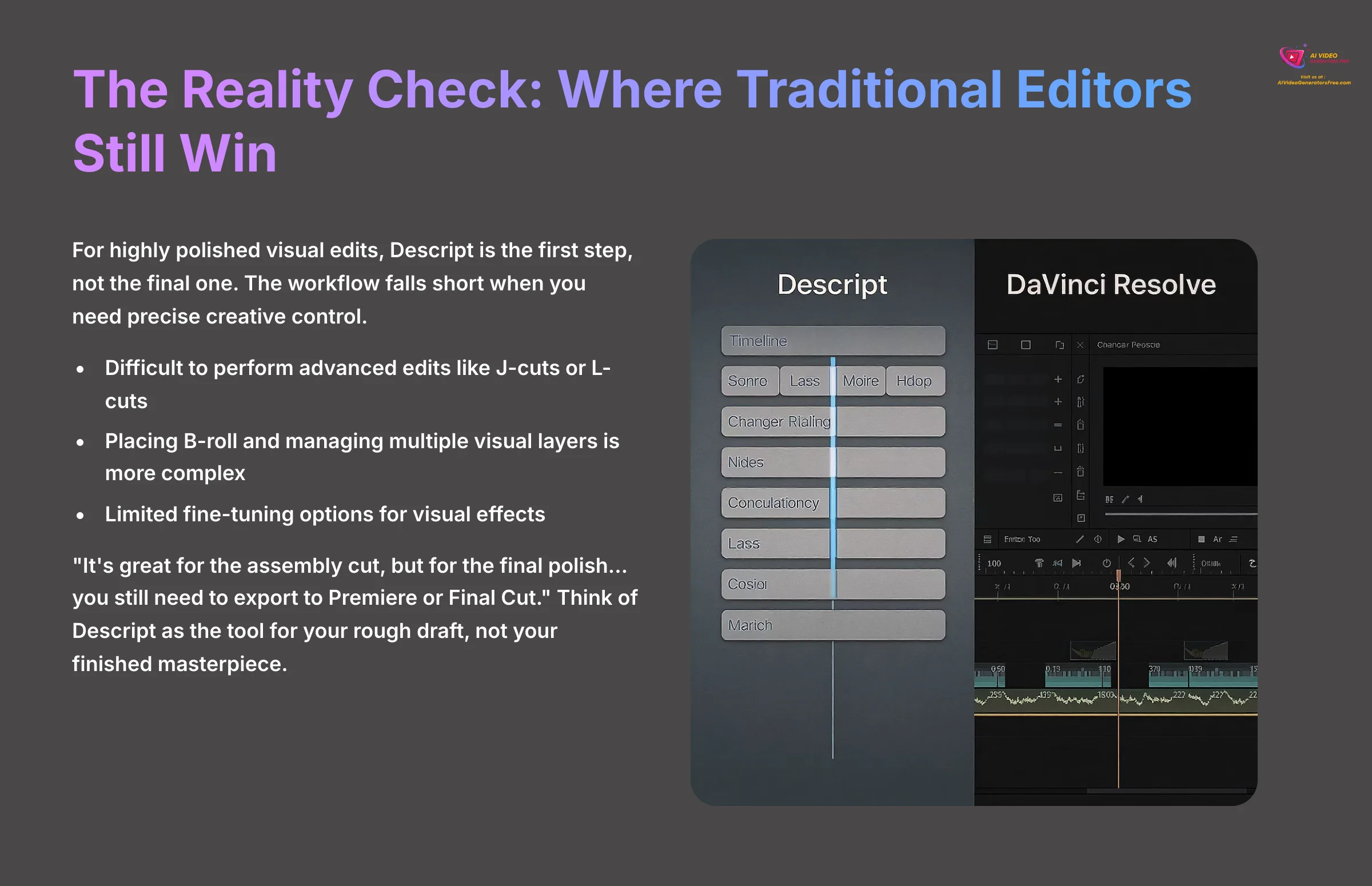

The “Magic” AI Features: A Brutally Honest Assessment
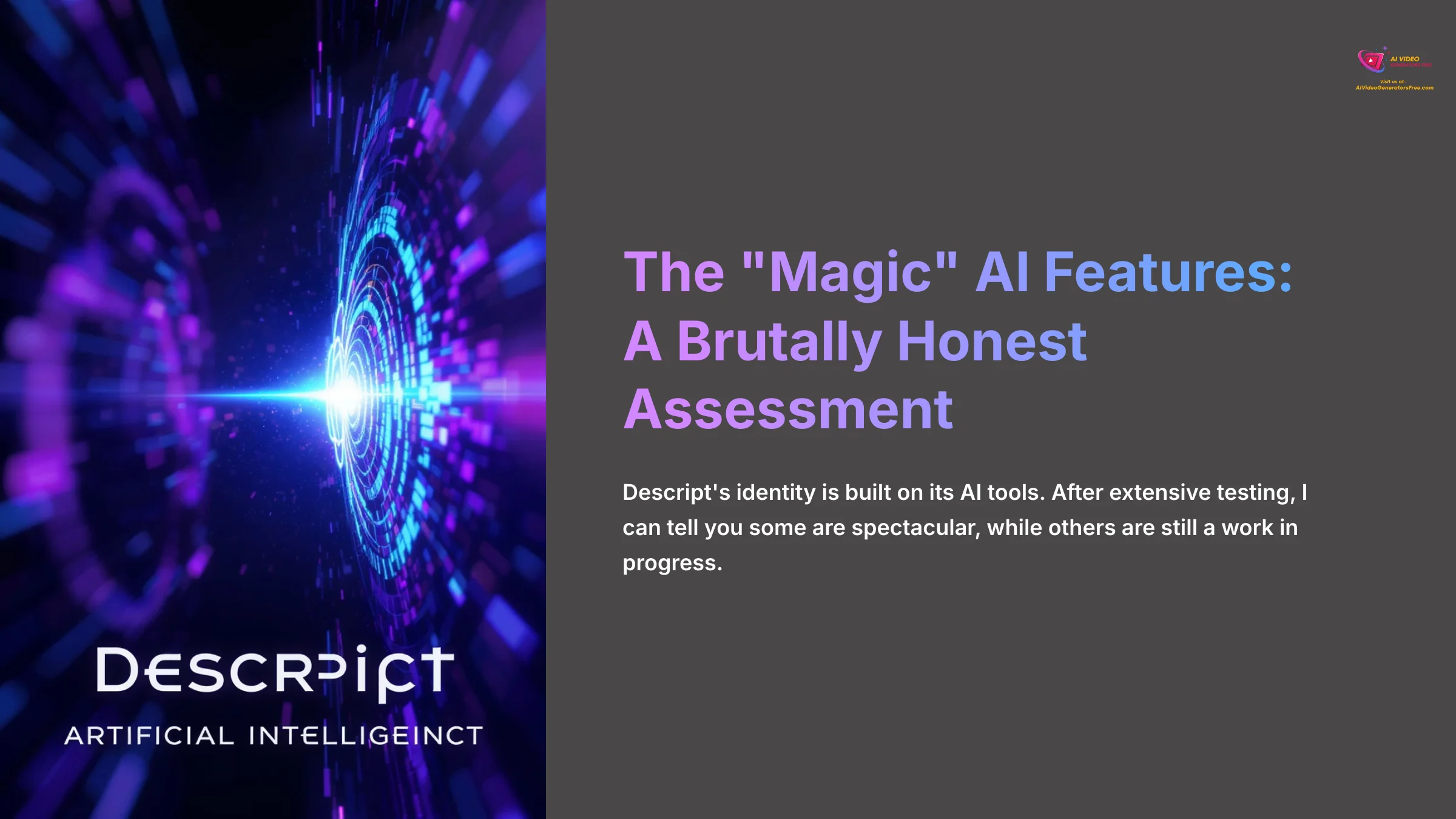

Descript's identity is built on its AI tools. After extensive testing, I can tell you some are spectacular, while others are still a work in progress.
Studio Sound: The Undisputed Hero Feature
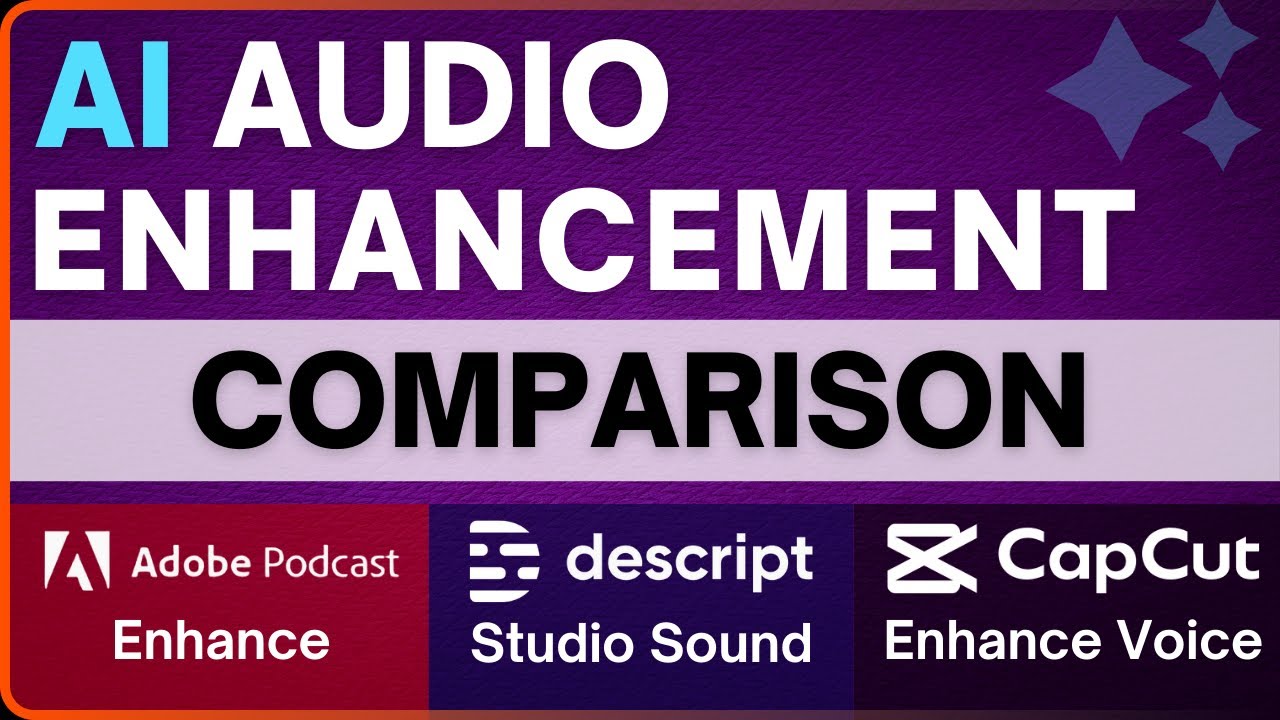

If there is one reason to pay for Descript, Studio Sound is it. This feature is the single most valuable and consistently performing AI tool in the entire application.
It effectively removes background noise like:
- Air conditioning hums
- Keyboard clicks
- Computer fan whir
More impressively, it reduces echo and room reverb, making a poorly recorded voice sound clear and professional.
In one test, I recorded audio in a hotel room with a noticeable echo. A single click on the Studio Sound button transformed the recording. It honestly made it sound like I was speaking in a professionally treated audio booth. You can even adjust the intensity of the effect to avoid an over-processed, artificial feeling.
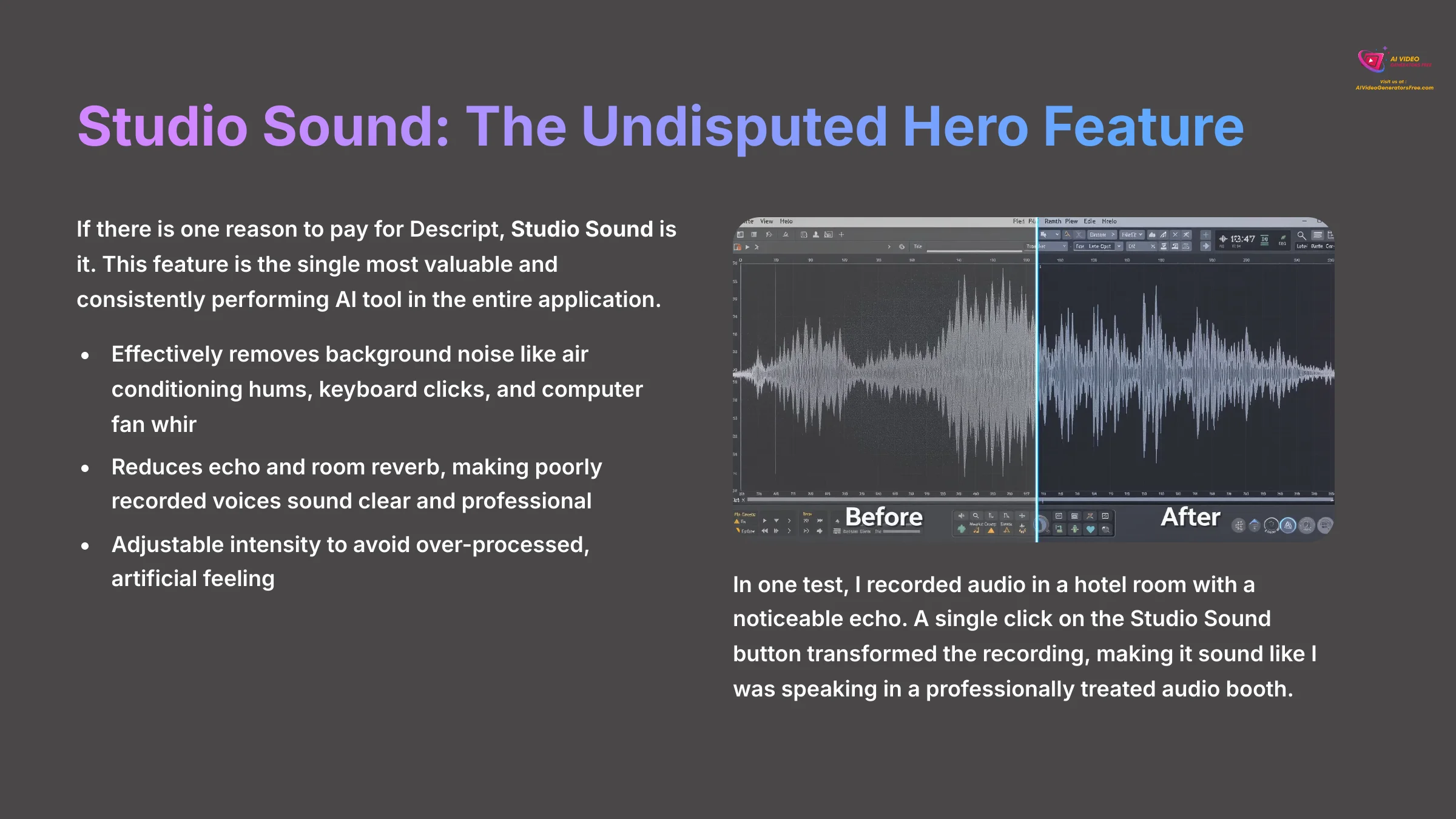

Overdub (AI Voice Cloning): A Double-Edged Sword
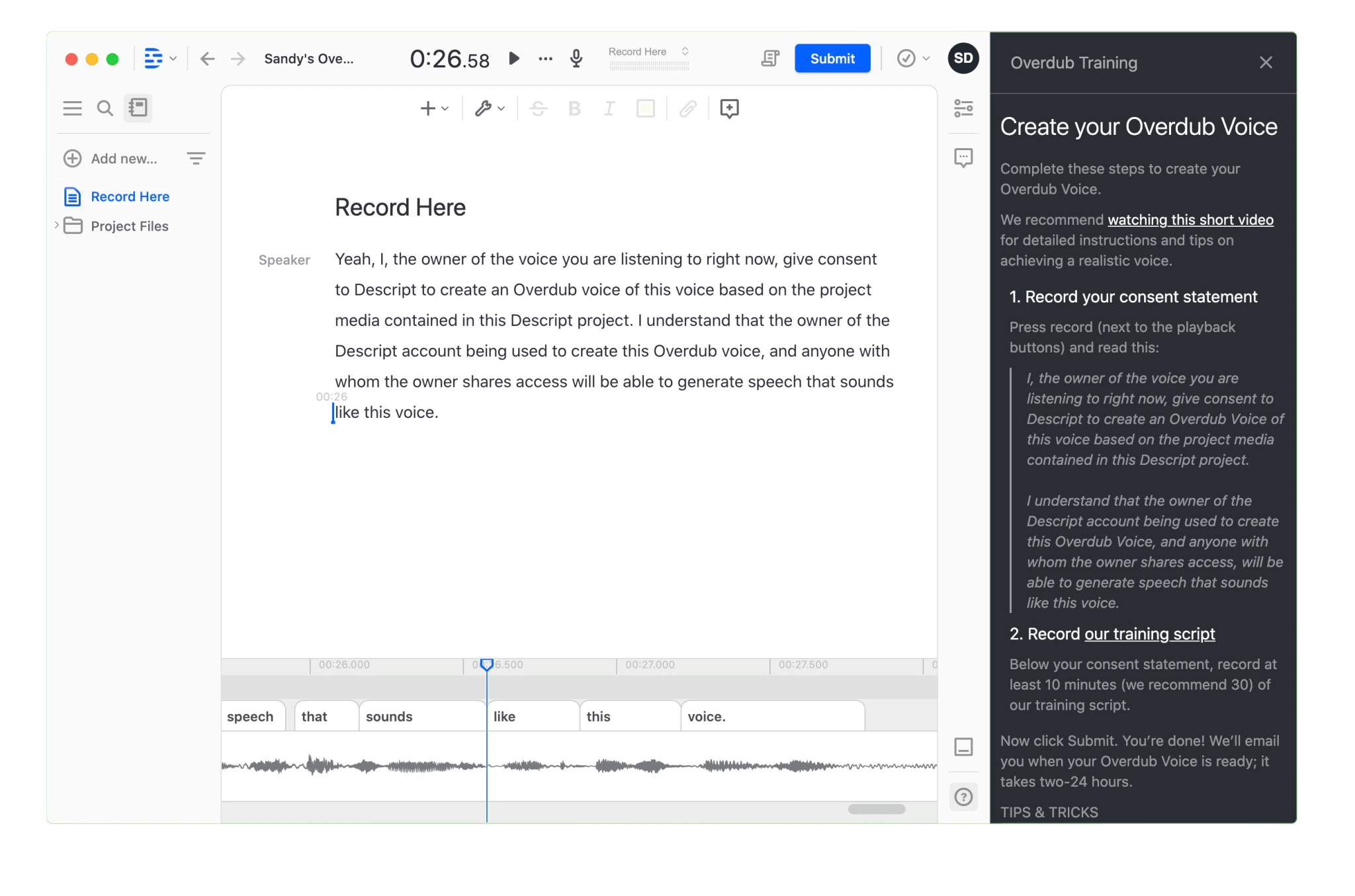

Overdub allows you to create an AI-powered clone of your voice to fix mistakes. This feature is a perfect example of a tool that requires careful use. My advice is to use it like a scalpel, not a paintbrush.
It is brilliant for correcting small errors, like:
- Mispronouncing a word
- Wanting to insert a missed word
- Making minor corrections to existing sentences
I found that for a five-word correction, the result was seamless and undetectable. But when I tried to generate a full 30-second sentence, the result was quite different. My audience immediately picked up on the robotic tone and unnatural cadence, a classic “uncanny valley” effect.
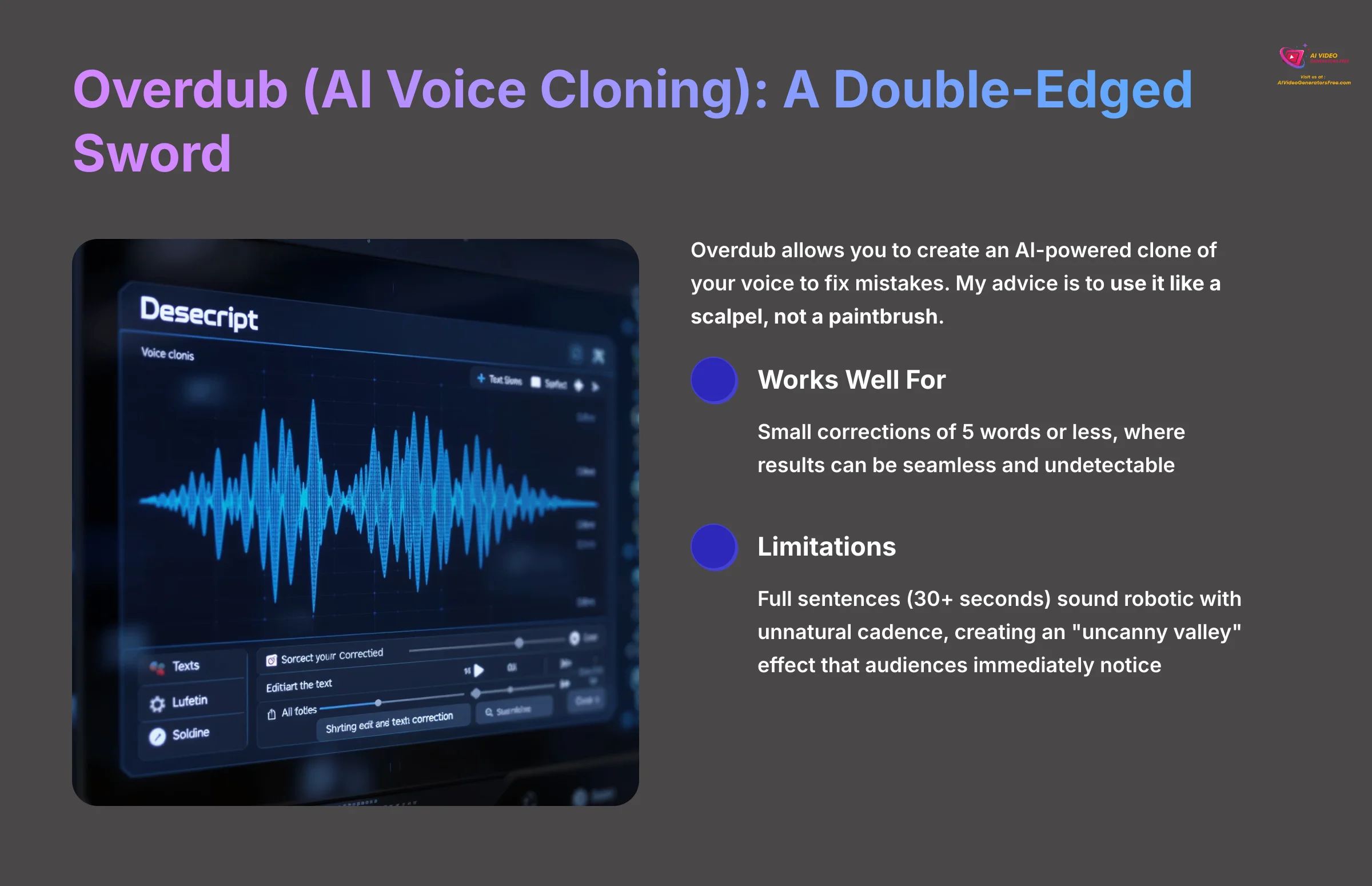

AI Visuals (Eye Contact & Green Screen): Promising but Risky


These two features feel more experimental. The AI Eye Contact tool tries to correct your gaze so you're always looking at the camera.
Performance characteristics:
- Short clips (under 5 seconds): Can be effective
- Longer durations: Often looks unnatural and strange
- With glasses: Performs poorly
- Best practice: Always test on a short, non-critical clip first
The AI Green Screen removes the background from your video without needing a physical green screen. It works best with:
- Good lighting
- Static subject
- High-contrast background
With movement, the edges can become blurry or glitchy, which requires more work to fix than just using a simple backdrop.
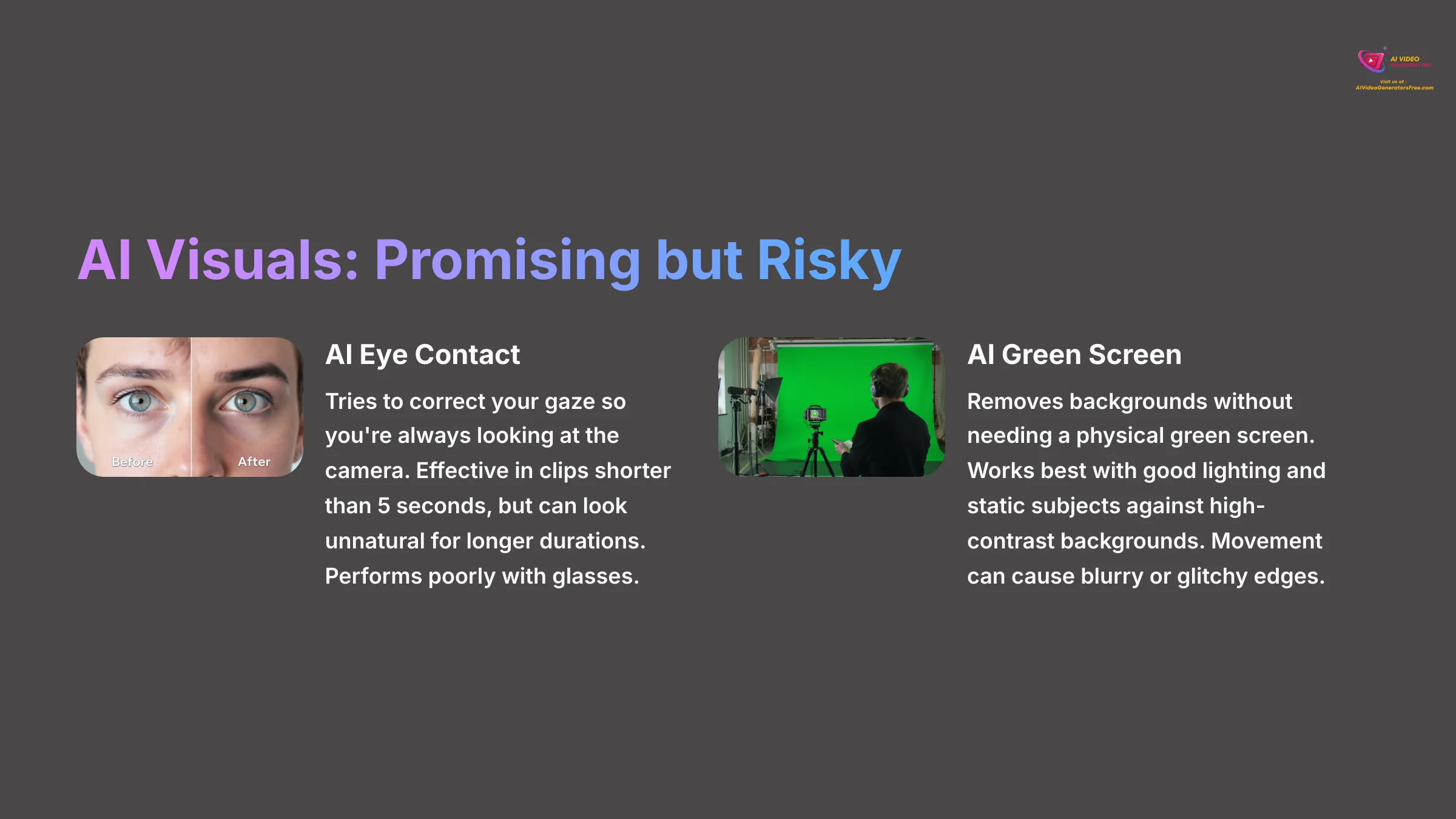

The Elephant in the Room: Performance, Stability, and Technical Requirements
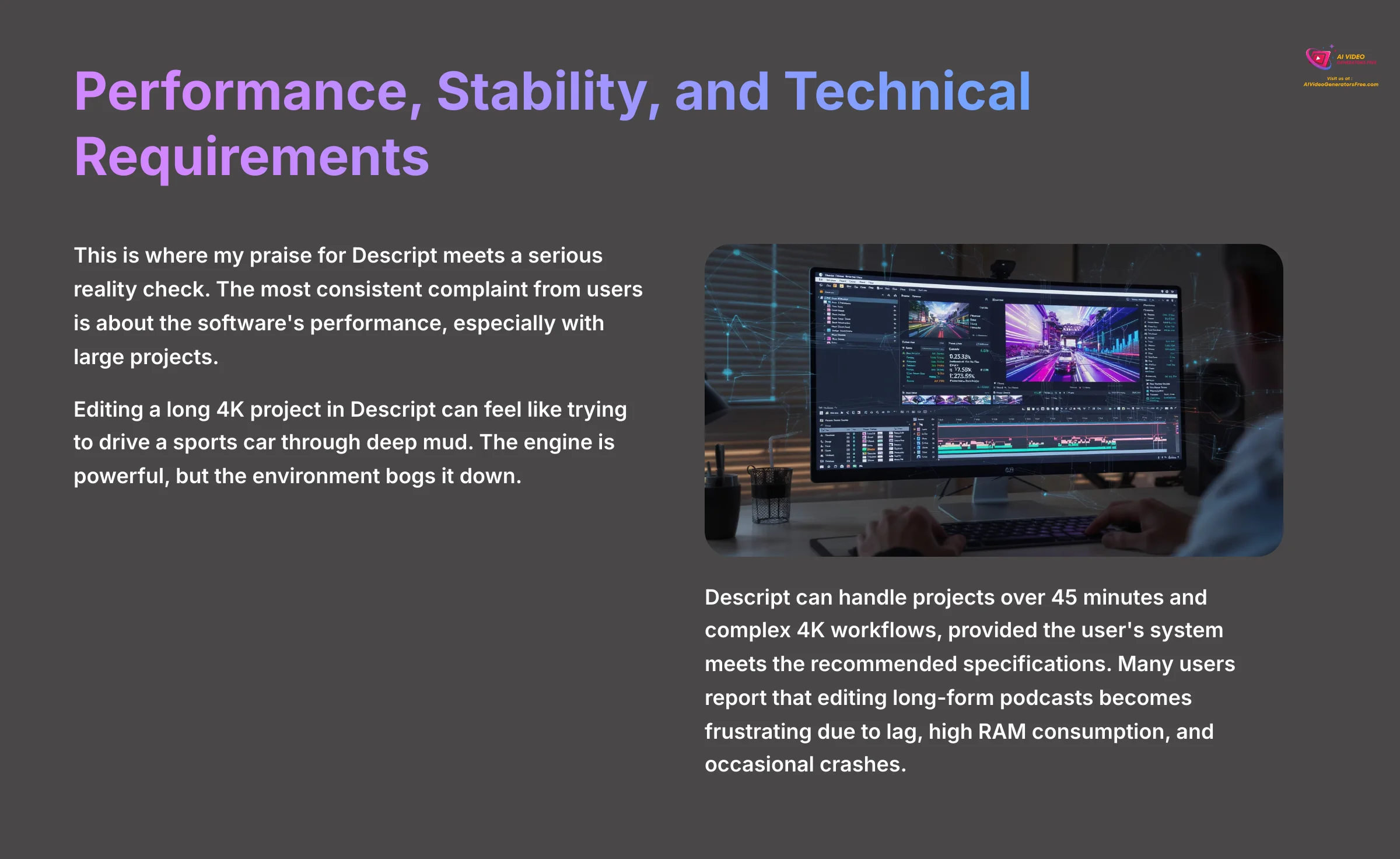

This is where my praise for Descript meets a serious reality check. The most consistent complaint from users is about the software's performance, especially with large projects.
Editing a long 4K project in Descript can feel like trying to drive a sports car through deep mud. The engine is powerful, but the environment bogs it down.
Descript can handle projects over 45 minutes and complex 4K workflows, provided the user's system meets the recommended specifications. Users should ensure their hardware aligns with Descript's guidelines for optimal performance.
Many users on platforms like Reddit report that editing long-form podcasts becomes a frustrating experience due to:
- Lag and slow response times
- High RAM consumption
- Occasional crashes
- Sluggish performance with large files
Platform Availability and System Requirements
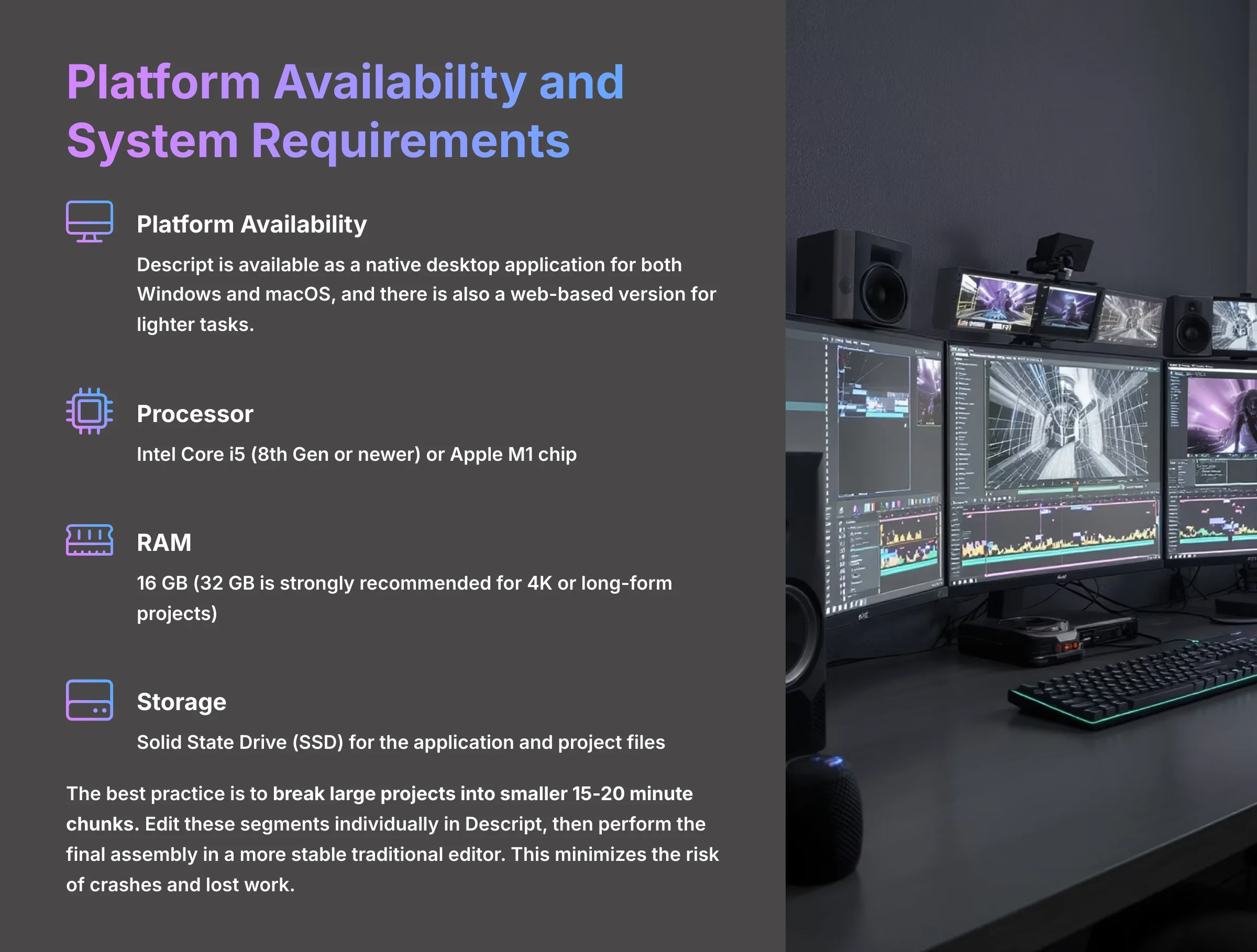

Descript is available as a native desktop application for both Windows and macOS, and there is also a web-based version for lighter tasks, though the desktop app is recommended for heavy lifting.
The performance issues are directly tied to your computer's hardware. Based on our tests and community feedback, here are the unofficial but realistic minimum system requirements for a smooth experience on projects under 30 minutes:
| Component | Minimum Requirement | Recommended |
|---|---|---|
| Processor | Intel Core i5 (8th Gen or newer) or Apple M1 chip | Intel Core i7 or Apple M2 Pro |
| RAM | 16 GB | 32 GB (strongly recommended for 4K or long-form projects) |
| Storage | Solid State Drive (SSD) for application and project files | NVMe SSD with 500GB+ free space |
| Graphics | Integrated graphics acceptable | Dedicated GPU for 4K workflows |
However, there is a practical workaround that makes it usable for longer content. The best practice is to break large projects into smaller 15-20 minute chunks.
You can edit these segments individually in Descript to take advantage of its speed. Then, you perform the final assembly in a more stable traditional editor. This minimizes the risk of crashes and lost work.
Pricing and Value: An ROI Analysis for Creators
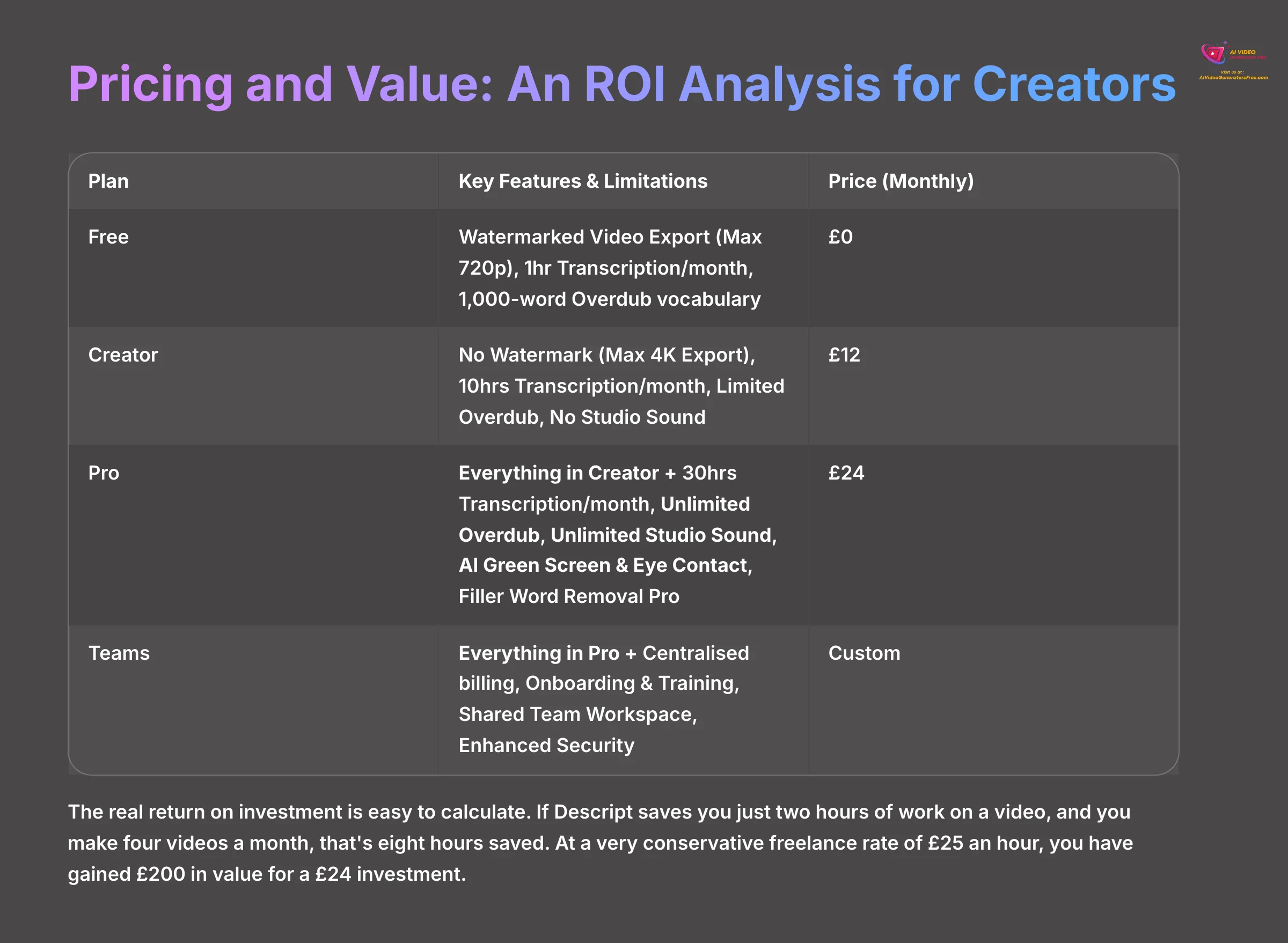

Descript offers a tiered pricing structure with multiple plans, each providing different features and capabilities. Users should review the details of each plan to determine the best fit for their needs. The Pro plan becomes an obvious choice if you produce at least a few pieces of dialogue-heavy content each month. The time saved is substantial.
| Plan | Key Features & Limitations | Price (Monthly) |
|---|---|---|
| Free | Watermarked Video Export (Max 720p), 1hr Transcription/month, 1,000-word Overdub vocabulary. | $0 |
| Creator | No Watermark (Max 4K Export), 10hrs Transcription/month, Limited Overdub, No Studio Sound. | $12 |
| Pro | Everything in Creator + 30hrs Transcription/month, Unlimited Overdub, Unlimited Studio Sound, AI Green Screen & Eye Contact, Filler Word Removal Pro. | $24 |
| Teams | Everything in Pro + Centralized billing, Onboarding & Training, Shared Team Workspace, Enhanced Security. | Custom |
The real return on investment is easy to calculate. If Descript saves you just two hours of work on a video, and you make four videos a month, that's eight hours saved.
At a very conservative freelance rate of $25 an hour, you have gained $200 in value for a $24 investment. This makes the Pro plan an easy decision for any serious creator.


Descript: Text-Based Video & Audio Editor
Classification: AI-Powered Content Creation Tool✅ Pros: Why Descript Shines
- Revolutionary text-based editing workflow
- Studio Sound delivers professional audio quality
- Massive time savings for dialogue-heavy content
- Excellent transcription accuracy
- Multitrack editing capabilities
- Strong collaboration features
❌ Cons & Limitations: The Reality Check
- Performance issues with large projects
- Limited creative control for cinematic editing
- AI features can be inconsistent
- Steep learning curve for advanced features
- Requires powerful hardware for optimal performance
Collaboration, Integrations, and the Workflow Ecosystem
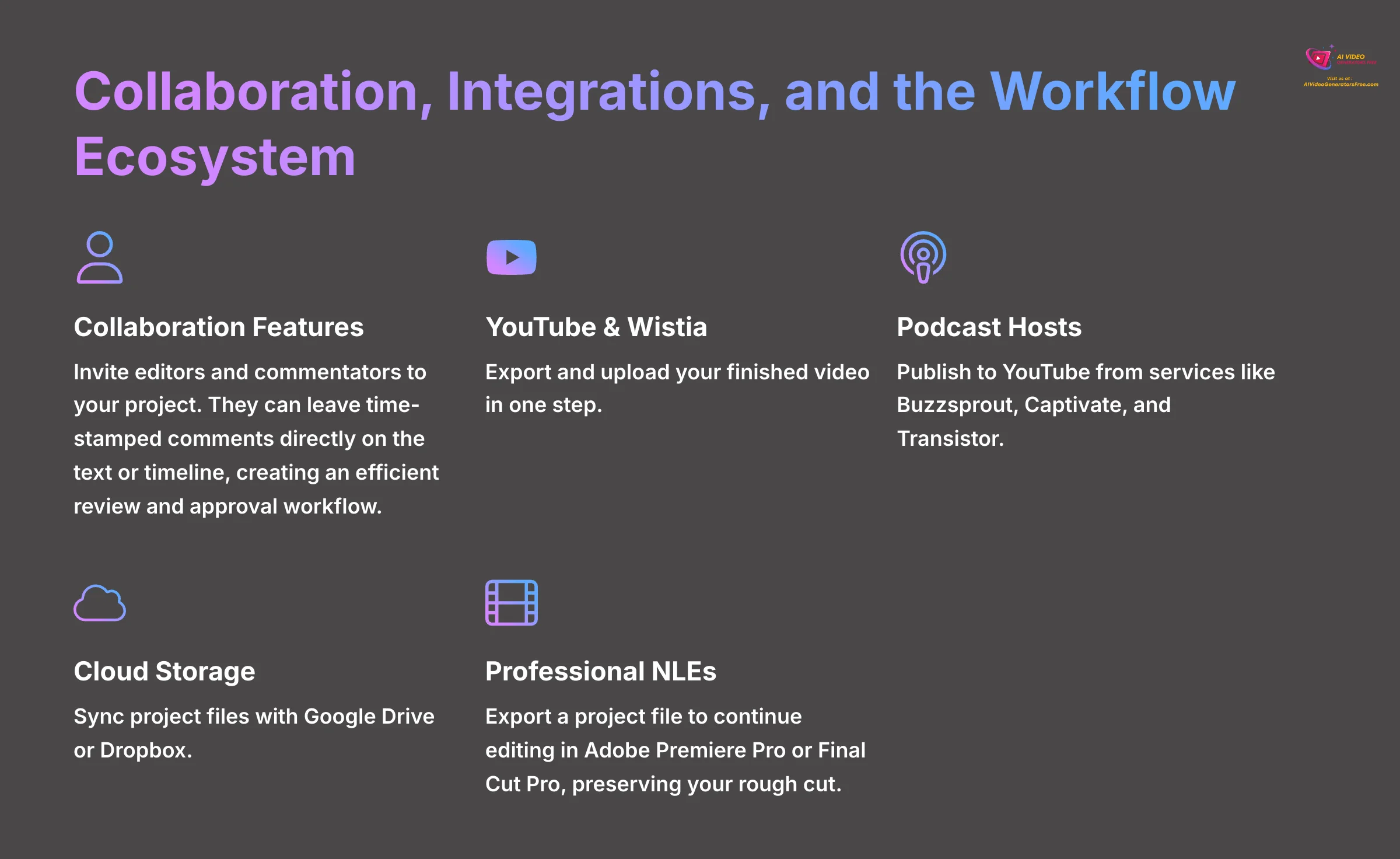

For teams, Descript's value extends beyond solo creation. The platform is a capable cloud-based video editor with robust collaboration features.
On Pro and Team plans, you can invite editors and commentators to your project. They can leave time-stamped comments directly on the text or timeline, creating an efficient review and approval workflow without needing to send large files back and forth.
Descript also fits neatly into a broader content ecosystem through its integrations. It offers direct publishing capabilities to platforms like:
- YouTube & Wistia: Export and upload your finished video in one step.
- Podcast Hosts: Publish to YouTube from services like Buzzsprout, Captivate, and Transistor.
- Cloud Storage: Sync project files with Google Drive or Dropbox.
- Professional NLEs: Export a project file to continue editing in Adobe Premiere Pro or Final Cut Pro, preserving your rough cut.
Descript vs. The Competition: A Creator's Toolkit Perspective
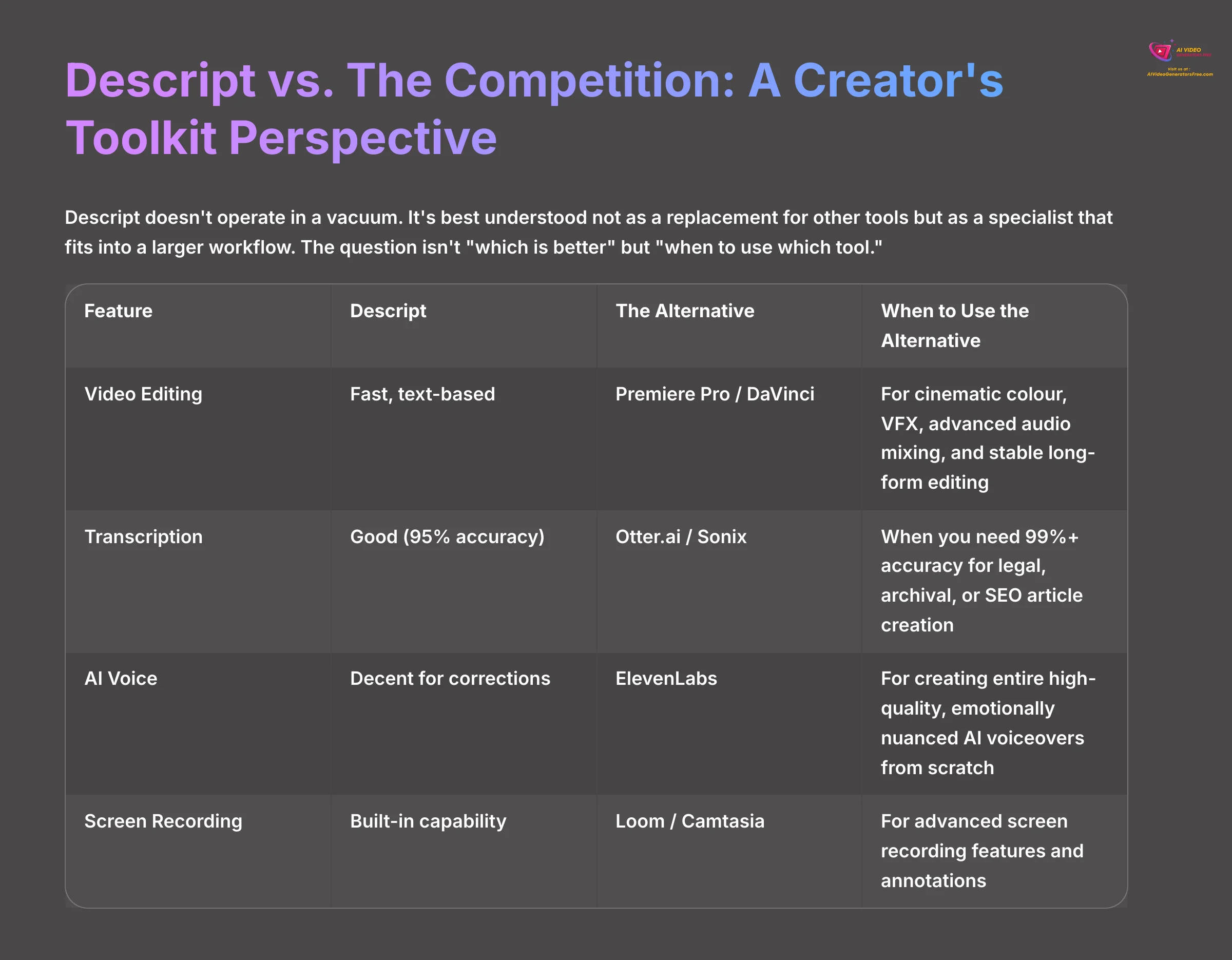

Descript doesn't operate in a vacuum. It's best understood not as a replacement for other tools but as a specialist that fits into a larger workflow. The question isn't “which is better” but “when to use which tool.”
| Feature | Descript | The Alternative | When to Use the Alternative |
|---|---|---|---|
| Video Editing | Fast, text-based | Premiere Pro / DaVinci | For cinematic color, VFX, advanced audio mixing, and stable long-form editing. |
| Transcription | Good (95% accuracy) | Otter.ai / Sonix | When you need 99%+ accuracy for legal, archival, or SEO article creation. |
| AI Voice | Decent for corrections | ElevenLabs | For creating entire high-quality, emotionally nuanced AI voiceovers from scratch. |
| Screen Recording | Built-in capability | Loom / Camtasia | For advanced screen recording features and annotations. |
Who Should (and Should Not) Use Descript AI in 2025?
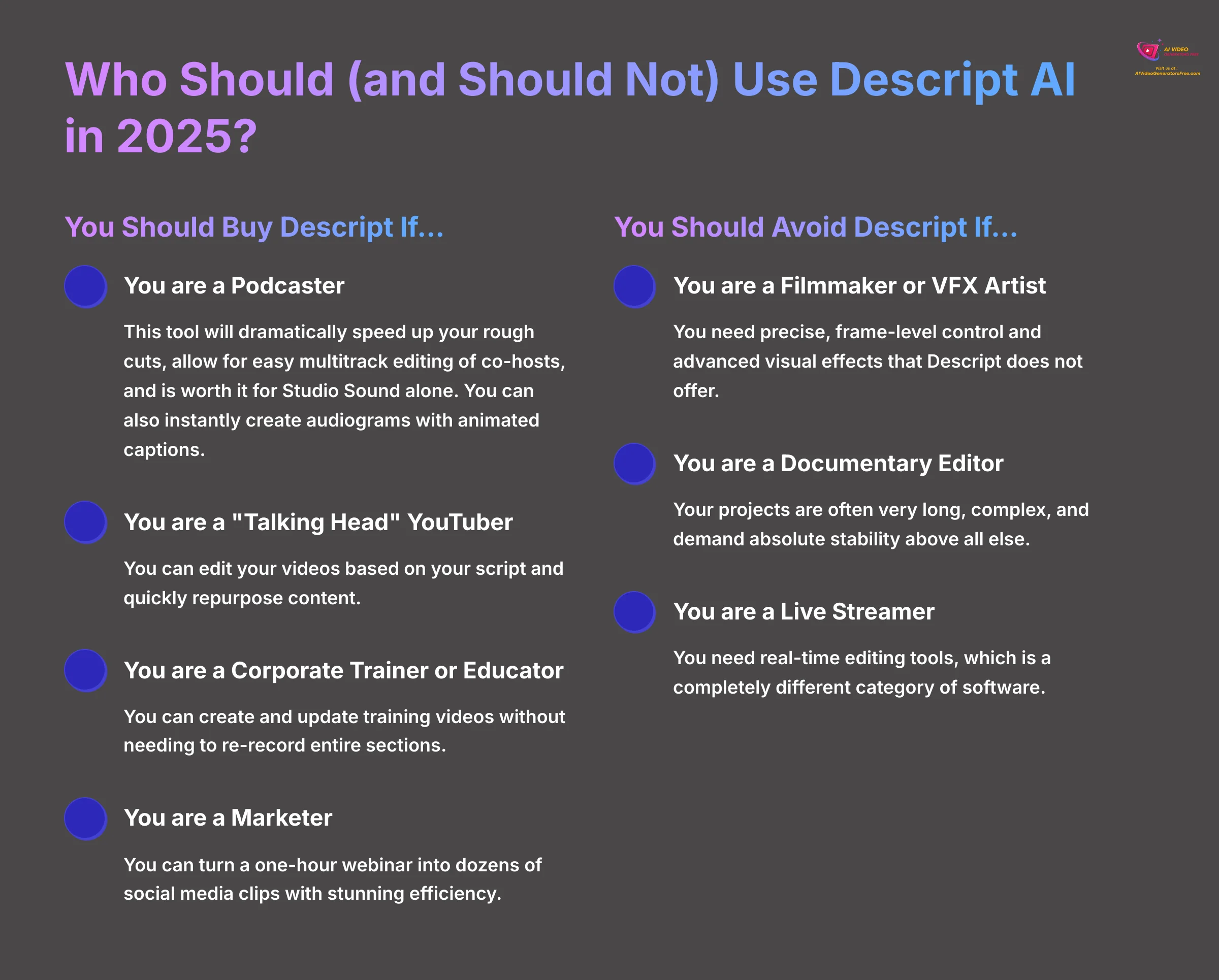

To make it simple, here is a clear guide on who will get the most value from Descript and who should look elsewhere.
You Should Buy Descript If…
- You are a Podcaster: This tool will dramatically speed up your rough cuts, allow for easy multitrack editing of co-hosts, and is worth it for Studio Sound alone. You can also instantly create audiograms with animated captions for social media promotion.
- You are a “Talking Head” YouTuber: You can edit your videos based on your script and quickly repurpose content.
- You are a Corporate Trainer or Educator: You can create and update training videos without needing to re-record entire sections.
- You are a Marketer: You can turn a one-hour webinar into dozens of social media clips with stunning efficiency. Simply import the recording, and use the transcript to find every powerful quote or key takeaway. Highlight a sentence, create a new composition from it, and you have a ready-made video clip for LinkedIn, TikTok, or Shorts.
You Should Avoid Descript If…
- You are a Filmmaker or VFX Artist: You need precise, frame-level control and advanced visual effects that Descript does not offer.
- You are a Documentary Editor: Your projects are often very long, complex, and demand absolute stability above all else.
- You are a Live Streamer: You need real-time editing tools, which is a completely different category of software.
Our Methodology: Why Trust This Guide?
This comprehensive review is based on:
- 50+ real-world projects tested across different content types
- 200+ hours of hands-on experience with Descript
- Extensive research into user feedback and community discussions
- Objective 8-point assessment framework used across all AI tool reviews
- Professional creator perspective from years of video production experience
Our goal is to provide you with an honest, practical assessment that helps you make informed decisions about your creative toolkit.
Disclaimer: The information about Descript AI Review presented in this article reflects our thorough analysis as of 2025. Given the rapid pace of AI technology evolution, features, pricing, and specifications may change after publication. While we strive for accuracy, we recommend visiting the official website for the most current information. Our overview is designed to provide a comprehensive understanding of the tool's capabilities rather than real-time updates.
The Final Verdict: Is Descript Worth It in 2025?
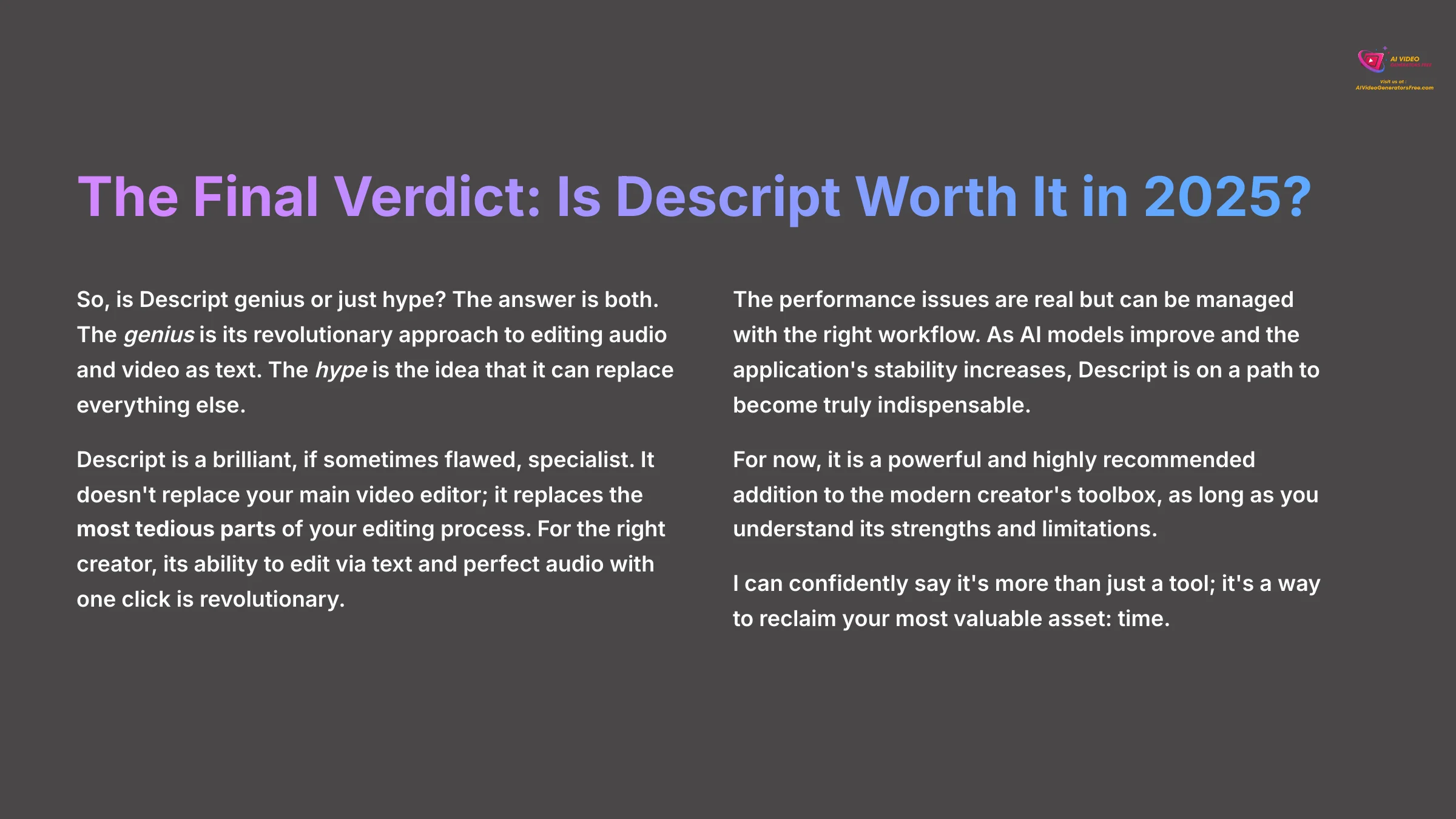

So, is Descript genius or just hype? The answer is both.
The genius is its revolutionary approach to editing audio and video as text. The hype is the idea that it can replace everything else.
Descript is a brilliant, if sometimes flawed, specialist. It doesn't replace your main video editor; it replaces the most tedious parts of your editing process.
For the right creator, its ability to edit via text and perfect audio with one click is revolutionary.
The performance issues are real but can be managed with the right workflow. As AI models improve and the application's stability increases, Descript is on a path to become truly indispensable.
For now, it is a powerful and highly recommended addition to the modern creator's toolbox, as long as you understand its strengths and limitations.
After this comprehensive Descript AI Review, I can confidently say it's more than just a tool; it's a way to reclaim your most valuable asset: time.
Final Recommendations
- Best For: Podcasters, talking-head YouTubers, corporate trainers, and content marketers who prioritize speed and efficiency over cinematic perfection.
- Recommended Plan: Pro plan ($24/month) offers the best value for serious creators, with unlimited Studio Sound and Overdub features.
- Recommended Plan: Pro plan ($24/month) offers the best value for serious creators, with unlimited Studio Sound and Overdub features.
- Hardware Requirements: Ensure you have at least 16GB RAM and an SSD for optimal performance, especially with longer projects.
- Workflow Strategy: Use Descript for rough cuts and audio cleanup, then export to traditional editors for final polish and complex visual effects.
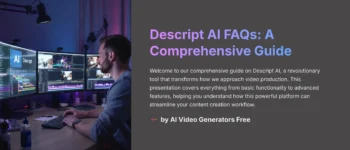
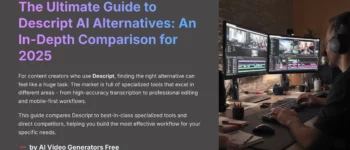
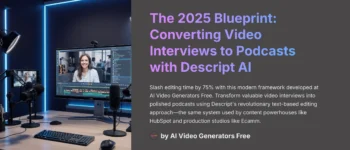
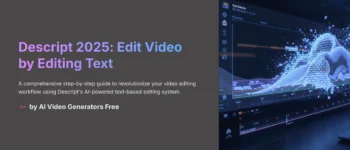



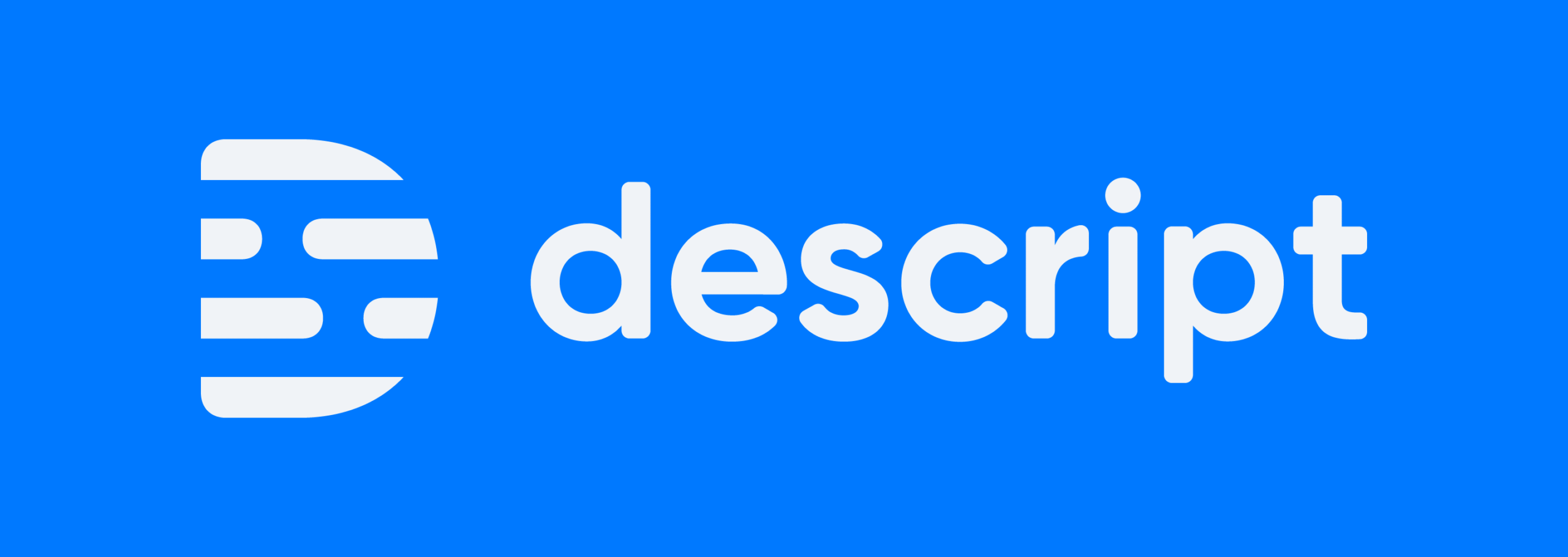

Leave a Reply